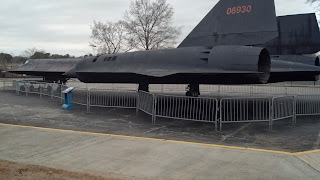Rusty & Kathy Lundy
Kathy worked for the NASA Marshall Space Flight Center in Huntsville for many years. We were often treated to "extra" tours of the facility on our visits. This trip we camped in the RV area on the grounds of the Space and Rocket Center and although we did not take the time for a tour, we did walk around the grounds and take a few pictures, as well as reminisce about all the amazing projects and experiments we had witnessed in the past .
Although Marshall Space Flight Center was not responsible for developing the space shuttle vehicle, it was responsible for all of the rocket propulsion elements. This facility developed the three main engines on the shuttle, the external tank that the shuttle rides on top of, and the rocket boosters attached to the sides of the vehicle. It was also responsible for Spacelab, the research area carried in the Shuttle's cargo bay on some flights.
From the start of the shuttle program in 1972, the management and development of Space Shuttle propulsion was a major activity at Marshall Space Flight Center. On one of our tours we were treated to a private tour of the area where these huge rocket engines were tested. The engineering of just the testing structure was mind boggling. It is incomprehensible trying to imagine how they designed the entire engine.
This shuttle model (now named Pathfinder) is the simulator built at the Marshall Space Flight Center in 1977 to be used for tests such as road clearances, crane capabilities, and how the shuttle would fit within structures. At one time it was used at the Kennedy space center for ground crew testing. Pathfinder is approximately the same size, shape, and weight of an actual Orbiter. Using this model for non mission activities allowed for support crew training without requiring use of the more delicate and expensive space shuttles.
At one point it this mock-up's life, the model was on view in Japan, then refurbished and returned to Marshall for display.
Walkways leading up to the visitors center have multiple signs about space activity and the planets. They are informative regarding the relative size of each planet as compared with the size of the sun, the planet composition, and the date when they were photographed by Voyager 2. I wonder if Lola can get a look at our close neighbor, Venus, with her new telescope?
At the time of Voyager 2, an approach to Pluto did not seem possible due to distance and its small size. However, on January 19, 2006 a mission, titled New Horizons, was successfully launched to explore Pluto. Its closest approach to Pluto will be on July 14, 2015. NASA is still doing some amazing space exploration even though we do not hear much about it.
Another tidbit for Lola! The sign below commemorates "Miss Baker" the first astronaut to go into space. It was quite a big deal at that time. Scientists had no idea what would happen to any mammal when up in space. Miss Baker's trip was a success.
This one is for Jed. Picture yourself flying this beauty. There is no notation of why this fantastic plane is displayed here but it is awesome to look at. If you single click on the picture it will become full screen and you can read the specifics on the sign. "New York to London - 1 hour 54 minutes! I'll take it.
The grounds and buildings are not as well cared for these days. They show the results of some severe budget cuts. Maintenance is usually one of the areas that get reduced first.












No comments:
Post a Comment